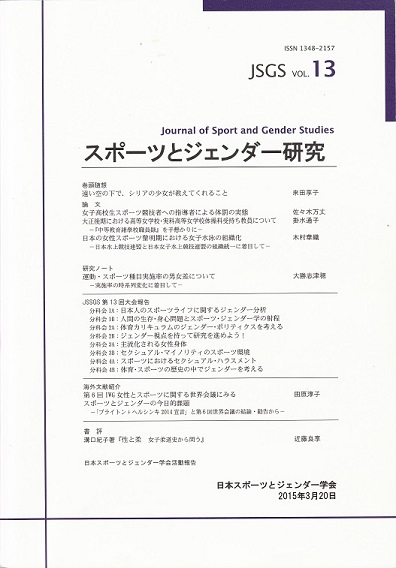Volume 5
Displaying 1-27 of 27 articles from this issue
- |<
- <
- 1
- >
- >|
-
2007Volume 5 Pages 2-3
Published: 2007
Released on J-STAGE: June 28, 2023
Download PDF (649K)
-
2007Volume 5 Pages 4-17
Published: 2007
Released on J-STAGE: June 28, 2023
Download PDF (749K) -
2007Volume 5 Pages 18-30
Published: 2007
Released on J-STAGE: June 28, 2023
Download PDF (739K) -
2007Volume 5 Pages 31-44
Published: 2007
Released on J-STAGE: June 28, 2023
Download PDF (1470K) -
2007Volume 5 Pages 45-55
Published: 2007
Released on J-STAGE: June 28, 2023
Download PDF (736K)
-
2007Volume 5 Pages 56-64
Published: 2007
Released on J-STAGE: June 28, 2023
Download PDF (1564K) -
2007Volume 5 Pages 65-71
Published: 2007
Released on J-STAGE: July 01, 2023
Download PDF (763K)
-
2007Volume 5 Pages 72
Published: 2007
Released on J-STAGE: June 28, 2023
Download PDF (657K) -
2007Volume 5 Pages 73-74
Published: 2007
Released on J-STAGE: June 28, 2023
Download PDF (659K)
-
2007Volume 5 Pages 75-76
Published: 2007
Released on J-STAGE: June 28, 2023
Download PDF (660K) -
2007Volume 5 Pages 76-78
Published: 2007
Released on J-STAGE: June 28, 2023
Download PDF (664K) -
2007Volume 5 Pages 78-80
Published: 2007
Released on J-STAGE: June 28, 2023
Download PDF (716K) -
2007Volume 5 Pages 81
Published: 2007
Released on J-STAGE: June 28, 2023
Download PDF (657K)
-
2007Volume 5 Pages 82-83
Published: 2007
Released on J-STAGE: June 28, 2023
Download PDF (675K) -
2007Volume 5 Pages 83-85
Published: 2007
Released on J-STAGE: June 28, 2023
Download PDF (679K) -
2007Volume 5 Pages 85-86
Published: 2007
Released on J-STAGE: June 28, 2023
Download PDF (660K) -
2007Volume 5 Pages 87-89
Published: 2007
Released on J-STAGE: June 28, 2023
Download PDF (679K) -
2007Volume 5 Pages 89-91
Published: 2007
Released on J-STAGE: June 28, 2023
Download PDF (688K) -
2007Volume 5 Pages 92-93
Published: 2007
Released on J-STAGE: June 28, 2023
Download PDF (675K) -
2007Volume 5 Pages 93-95
Published: 2007
Released on J-STAGE: June 28, 2023
Download PDF (679K) -
2007Volume 5 Pages 95-98
Published: 2007
Released on J-STAGE: June 28, 2023
Download PDF (657K) -
2007Volume 5 Pages 98-99
Published: 2007
Released on J-STAGE: June 28, 2023
Download PDF (660K) -
2007Volume 5 Pages 100-101
Published: 2007
Released on J-STAGE: June 28, 2023
Download PDF (686K) -
2007Volume 5 Pages 101-104
Published: 2007
Released on J-STAGE: June 28, 2023
Download PDF (683K)
-
2007Volume 5 Pages 106-107
Published: 2007
Released on J-STAGE: July 01, 2023
Download PDF (628K) -
2007Volume 5 Pages 107-120
Published: 2007
Released on J-STAGE: July 01, 2023
Download PDF (757K)
-
2007Volume 5 Pages 121-122
Published: 2007
Released on J-STAGE: June 28, 2023
Download PDF (677K)
- |<
- <
- 1
- >
- >|
